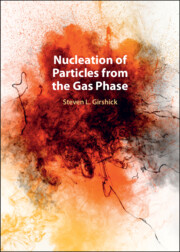Book contents
- Nucleation of Particles from the Gas Phase
- Reviews
- Nucleation of Particles from the Gas Phase
- Copyright page
- Dedication
- Contents
- Preface
- Symbols
- 1 Introduction
- 2 Single-Component Homogeneous Nucleation from a Supersaturated Vapor
- 3 Classical Nucleation Theory
- 4 Classical Theory of Multicomponent Nucleation
- 5 Classical Theory of Ion-Induced Nucleation
- 6 Atomistic Approaches to Homogeneous Nucleation
- 7 Transient Nucleation
- 8 Chemical Nucleation
- 9 Nucleation in Plasmas
- References
- Index
3 - Classical Nucleation Theory
The Liquid Droplet Model
Published online by Cambridge University Press: 30 May 2024
- Nucleation of Particles from the Gas Phase
- Reviews
- Nucleation of Particles from the Gas Phase
- Copyright page
- Dedication
- Contents
- Preface
- Symbols
- 1 Introduction
- 2 Single-Component Homogeneous Nucleation from a Supersaturated Vapor
- 3 Classical Nucleation Theory
- 4 Classical Theory of Multicomponent Nucleation
- 5 Classical Theory of Ion-Induced Nucleation
- 6 Atomistic Approaches to Homogeneous Nucleation
- 7 Transient Nucleation
- 8 Chemical Nucleation
- 9 Nucleation in Plasmas
- References
- Index
Summary
Classical nucleation theory (CNT) models clusters of all sizes as structureless, spherical liquid droplets, having the same surface tension as a flat surface of the bulk liquid in equilibrium with its vapor at the same temperature – the “capillarity approximation.” The cluster free energy is divided into volume and surface contributions, and the rate of monomer addition to a cluster per unit area is equated to the flux of molecules to a plane in an ideal gas. Under these assumptions, together with several mathematical approximations, the summation expression for the steady-state nucleation rate is converted to a closed-form analytical expression for the nucleation rate as a function of temperature, saturation ratio, and substance properties. Comparing the nucleation rate predicted by CNT to experimental results for many substances, one finds considerable disagreement in terms of the magnitude of the nucleation rate as well as the qualitative dependence of nucleation rate on both temperature and saturation ratio. Analyzing the possible sources of this discrepancy, by far the major source of error is the liquid droplet model for the Gibbs free energy of cluster formation.
Keywords
- Type
- Chapter
- Information
- Nucleation of Particles from the Gas Phase , pp. 32 - 93Publisher: Cambridge University PressPrint publication year: 2024

